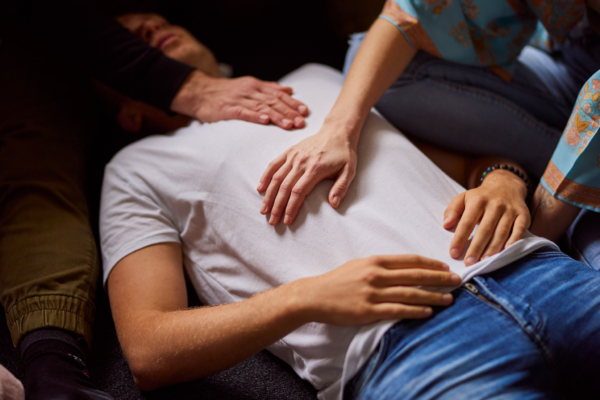


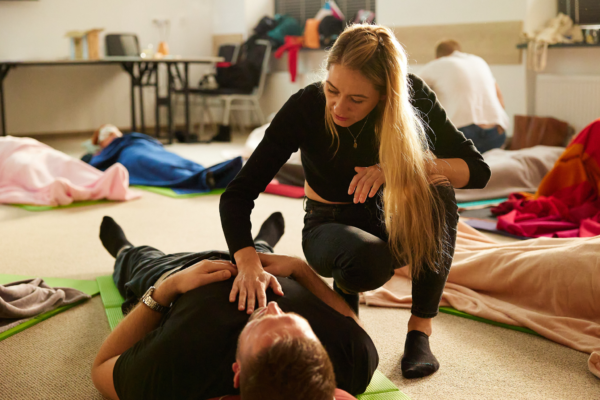

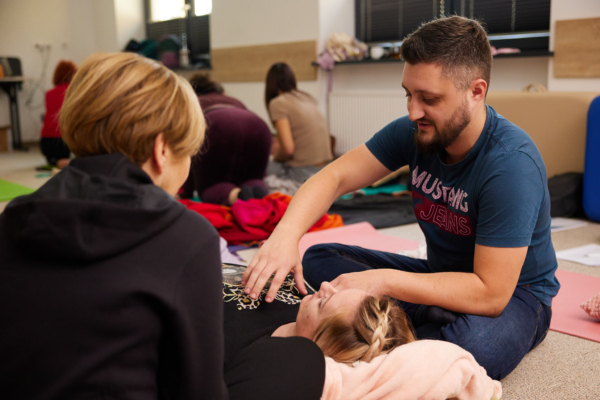

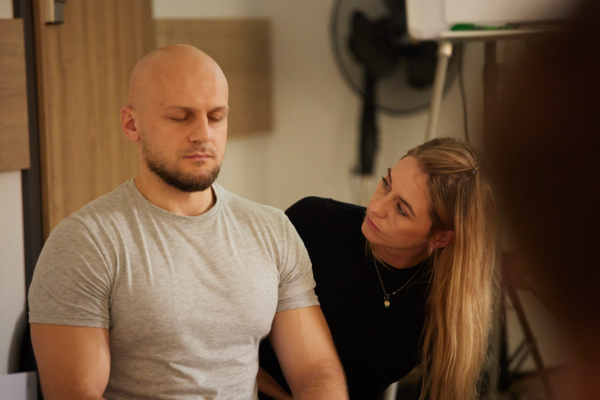







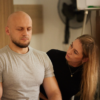
ETER neuropsychobiological bases of work with the body
2 450,00 zł
The course consists of a theoretical and practical part and will provide the necessary knowledge and skills to acquire the basics of work necessary for independent practice in the fifth regulator from the very beginning called Ether.
26 godzin
hours
45 educational
points
Place:
Spała
Funding
KFS / BUR
What is the Ether course
The course is designed to show how strong the connection between the body and the mind is, to present what this connection is all about and to teach methods of therapeutic influence on disorders passing through this connection from psyche to soma and from soma to psyche.
The cause of the vast majority of medically unexplained somatic symptoms is, for example, anxiety. It is enough for psychiatrists to use the knowledge acquired during medical studies to see these patients in a different light.
Patients who complain of neck and spine pain suffer from anxiety channeled through the somatic nervous system, which activates striated muscles.
Patients who suffer from irritable bowel syndrome, diarrhea, migraines and stomach pain suffer from anxiety stored in the parasympathetic nervous system, which activates the smooth muscles in the blood vessels and the lining of the gastrointestinal tract.
However, patients who complain of loss of consciousness, blurred vision, ringing in the ears, or cognitive or perceptual disturbances suffer from parasympathetic anxiety to such an extent that it causes a decrease in blood flow to the brain and a shutdown of the prefrontal cortex and hippocampus due to neurohormones. .
In other words, the cause of the vast majority of these unexplained symptoms turns out to be anxiety acting in the central nervous system.
If we help patients see what happened before these symptoms appeared, we will discover the emotional trigger. Then we help patients endure the feeling, notice the fear it arouses and teach them to regulate this fear.
Next, we gradually help the patient endure the feeling of increasing intensity until it no longer causes anxiety and the resulting somatic symptoms.
Jon Frederickson
Autoregulation of the nervous system is a key element in restoring balance in the body and mind, and a relaxed, relaxed body helps us better navigate our lives.
Have you ever encountered in your therapeutic practice (especially after therapy with needles, pins or manipulations) typical body reactions in your patients and emotional discharge, such as crying, laughing, fainting?
During the course, through our own experience, we will discuss the entire regulatory and integration process and how to support our patients in times of crisis.

What will you learn during Eter course?
The proposed work techniques are based on 3 basic principles of a good therapy/treatment process:
- Autonomous hierarchy – you will learn to recognize at what level of the hierarchy the nervous system is and how it subordinated the body and mind. The proposed therapeutic techniques will enable the activation of cooperation between the body and consciousness, so the therapeutic process and change were possible.
- Neuroception – that is, constantly outside our consciousness, the assessment of the state of environmental security, is the way in which the autonomic nervous system interacts with the world. Therefore, an important part of the training will be learning: creating a space of therapeutic and relational presence and building the patient's trust in the therapy process and the ability to tune in to hidden autonomous conversations taking place between you and the patient, along with occupational health and safety techniques supporting the therapist.
- Co-regulation “By co-regulation, we connect with others and create a sense of security. The regulated and regulating presence of the therapist is an important factor in the success of therapy. If you do not provide the patient with a sense of security during the session, it will be difficult for him to enter the path of health.
In addition, you will learn:
- creating a safe, empathetic therapeutic space – essential in the recovery process
- narzędzi i technik wspierających świadomość i czucie ciała np. techniki QRu – to technika, która pomoże w pogłębieniu świadomości w kontakcie z ciałem i w uwrażliwieniu na niego.
- how to access sensation in the body and why it was blocked
- how mental-emotional patterns influence behavioral and cognitive states and physiology, tissue and organ structures, the nervous system and its reactivity
- how to release blockages stored in the body, and then how to start the process of creating new neural patterns (brain plasticity) to adapt the body to the "new" mind and emotions (trauma and its effects in the body and hyperreactivity of the nervous system)f
- what are habitual reactions and how they affect the body and behavior
- how to relax through conscious regulation and self-regulation
- how to build a sense of integration in the therapeutic process at the time of intense feelings
- how to create tolerance in the body to very intense situations and life events, both pleasant and unpleasant (without running away from them or constantly muting them, creating a circle of self-aggression)
- you will learn the adaptation process, supporting your personal development in its various phases
- how to support YOURSELF to prevent burnout (so-called "rescuer safety" / "helper syndrome")
Ability to regulate emotions:
- It involves building awareness of what is being experienced.
- It helps us express in an adequate way what is inside us and about us.
- It helps to stop, postpone or refrain from expressing.
- People who can regulate emotions also have the ability to soothe themselves when they are going through something difficult or heavy, and they can also ask for help.
For whom is this course?
We invite physiotherapy students and representatives of medical professions to the course: doctor, dentist, surgeon, physiotherapist, nurse, midwife, paramedic, massage technician, osteopath, medical assistant, orthopedic technician, occupational therapist.
There is no need to complete Manual Medicine course by FRSc.
This is a training for people interested in practical implementation of neurobiological discoveries into therapy, and for FRSc practitioners it is a job offer as the fifth regulator.
These are practical applications of knowledge based on reports from the field of neurobiology, according to which the brain is an adaptive system, which means that it can be modified by specific stimuli and change its reactivity.
Do you work in another medical profession? Contact us!
Contraindications
Disorders: blood pressure, heart function (arrhythmia, heart pacemaker, surgery); physical and physiological limitations: bone fractures, joint strains and sprains, postoperative conditions; spinal instability that causes pain symptoms; hypo/hyperglycemia, epilepsy, pregnancy; Psychiatric diseases treated pharmacologically: psychosis, deep depression, schizophrenia.
Classes will be in the form of exercise and therapy, so that you can better understand this form of work with the patient through your own experience. Practical exercises will be performed individually, in pairs and in a group.
09:00 – 09:45
Wprowadzenie – podejście oparte na ciele, relacji i regulacji. Rola soma, psyche i układu nerwowego w procesie terapeutycznym
09:45 – 10:30
Relacja ciało–psyche–AUN –jak układ nerwowy tworzy doświadczenie, odpowiada na kontakt i wspiera zmiany w strukturze reakcji
10:30 – 10:45
Break
10:45 – 11:30
Neuroświadomość – interocepcja, propriocepcja
11:30 – 12:15
Mechanizmy zapisu doświadczeń w strukturach ciała i układu nerwowego
12:15 – 12:30
Break
12:30 – 13:15
Technika QR – trening percepcji sygnałów płynących z ciała
13:15 – 14:00
Percepcja somatyczna – ciało jako mapa wewnętrznych sygnałów. Zauważanie, czucie, obserwacja i pierwsze kroki w regulacji
14:00 – 15:00
Break
15:00 – 15:45
Praktyka QR – jak ciało sygnalizuje przeciążenie. Rozpoznawanie wczesnych somatycznych znaków alarmowych
15:45 – 16:30
Głęboka praktyka QR – praca z przeciążeniem układu nerwowego i reakcjami wegetatywnymi
16:30 – 16:45
Break
16:45 – 17:30
Podsumowanie – jak wspierać ciało w integracji doświadczeń.
17:30 – 18:15
Wnioski z praktyki
09:00 – 09:45
Empatia i współodczuwanie – mechanizmy neuronalne dostrajania się do drugiego człowieka
09:45 – 10:30
Rola terapeuty w regulacji – neurobiologiczne podstawy koregulacji i odporności psychicznej
10:30 – 10:45
Break
10:45 – 11:30
Regulacja w relacji terapeutycznej – od dostrojenia do dysocjacji.
11:30 – 12:15
Mechanizmy wycofania i przeciążenia w kontakcie terapeutycznym
12:15 – 12:30
Break
12:30 – 13:15
Dialog terapeutyczny jako narzędzie regulacji – obecność, parafraza i dozowanie kontaktu
13:15 – 14:00
Czaszka, napięcia i układ autonomiczny – wpływ podstawy czaszki na działanie nerwu błędnego i integrację regulacyjną
14:00 – 15:00
Break
15:00 – 15:45
Biomechanika i fizjologia obszaru głowowo-szyjnego – wpływ napięć na układ wegetatywny i emocjonalny
15:45 – 16:30
Techniki manualne i trakcja podstawy czaszki – praktyka w parach
16:30 – 16:45
Break
16:45 – 17:30
Obserwacja reakcji regulacyjnych – jak rozpoznawać napięcie, wycofanie, przeciążenie
17:30 – 18:15
Zasoby terapeuty – jak wspierać pacjenta bez przekraczania własnych granic. Regulacja, odporność psychiczna terapeuty i prewencja wypalenia zawodowego
09:00 – 09:45
Jak działa autonomiczny układ nerwowy – reakcje współczulne i przywspółczulne w praktyce
09:45 – 10:30
Somatyczne wzorce zaburzeń – relacja postawy ciała, ekspresji, napięcia i wzorców emocjonalnych
10:30 – 10:45
Break
10:45 – 11:30
Somatyczna regulacja i integracja. Wsparcie układu nerwowego po intensywnej terapii manualnej, narzędziowej, igłowaniu lub silnych reakcjach emocjonalnych.
11:30 – 12:15
Domykanie procesu terapeutycznego. Techniki wspierające równowagę i odporność psychiczną po głębokiej stymulacji somatycznej – jak unikać przeciążenia i wspierać adaptację.
12:15 – 12:30
Break
12:30 – 13:15
Integracja rytmu i regulacji. Praca ze stanami harmonii, synchronizacji i spójności w układzie nerwowym. Neuroregulacja przez ciało jako domknięcie procesu terapeutycznego.
13:15 – 14:00
Sesja końcowa – podsumowanie procesu. Integracja wiedzy, refleksje kliniczne i praktyczne wnioski do pracy zawodowej. Wdrożenie do praktyki terapeutycznej.

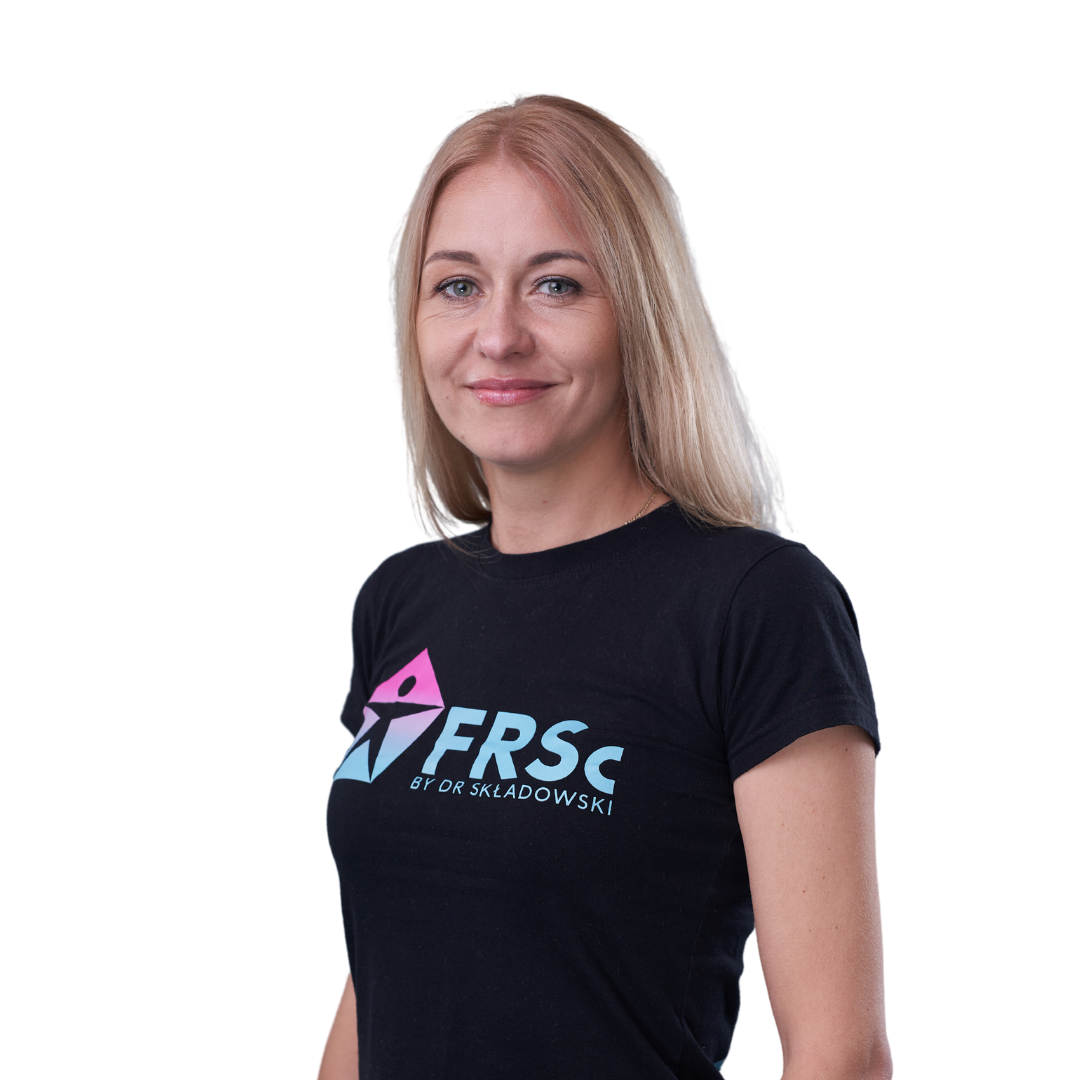
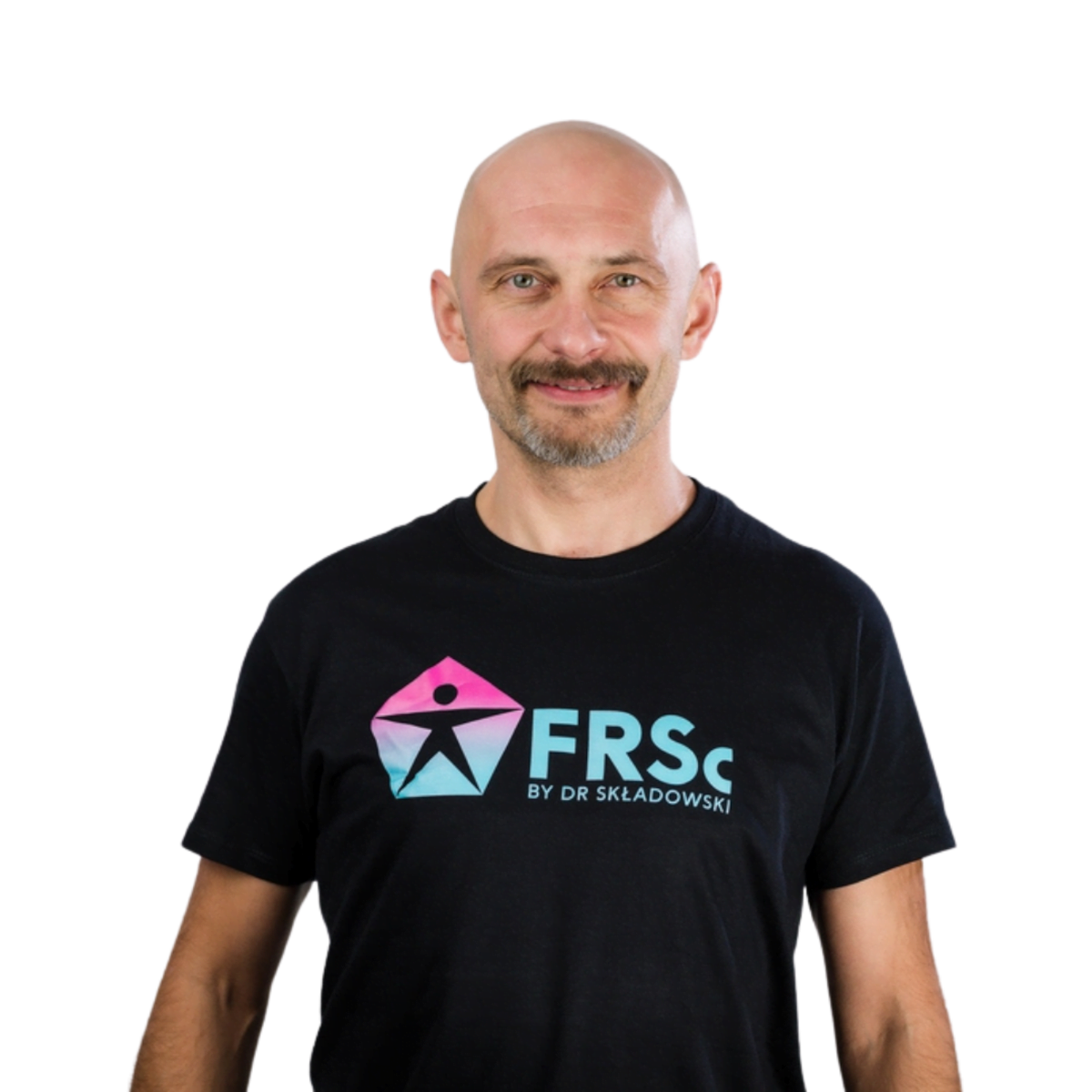

Ula –
Nowy rozdział w pracy z bólem,którego podłożem są emocje -to trzeba przeżyć na własnej skórze by zrozumieć.Polecam!!!